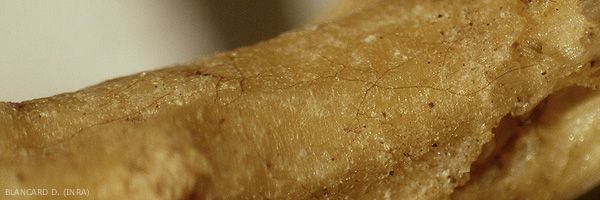
Thanatephorus cucumeris (A.B. Frank) Donk (1956)
Rhizoctonia
- Classification: Fungi, Basidiomycota, Cryptomycocolacomycetes, Incertae_sedis_, Cantharellales, Ceratobasidiaceae
- synonymie : Rhizoctonia solani J.G. Kühn (1858)
- English names: damping-off, fruit rot
T. cucumeris (syn. R. solani ) is widespread worldwide and reported in many production areas of Cucurbits, and of zucchini and squash. It is capable of infecting several hundred different hosts and several Cucurbits: watermelon, cucumber, melon, zucchini and squash, christophine, bitter gourd ( Momordica charantia ), wax squash ( Benincasa hispida ) ...
On zucchini, this telluric fungus is best known to cause damping-off in nurseries, root and crown lesions. This is particularly the case in France .
It should be noted that it is considered to be a biological marker for “tired” market garden soils which have repeatedly borne Cucurbitaceae and / or other sensitive vegetable crops.
Much work has been done on this fungus in ubiquitous and polyphagous order to characterize the diversity of its strains. Indeed, these differ among other things by their cultural characteristics, their pathogenicity and in particular their host specificity. Among the differentiation criteria studied, their anastomosis affinities have made it possible to establish more than ten groups (GA), and sometimes even subgroups.
- synonymie : Rhizoctonia solani J.G. Kühn (1858)
- English names: damping-off, fruit rot
T. cucumeris (syn. R. solani ) is widespread worldwide and reported in many production areas of Cucurbits, and of zucchini and squash. It is capable of infecting several hundred different hosts and several Cucurbits: watermelon, cucumber, melon, zucchini and squash, christophine, bitter gourd ( Momordica charantia ), wax squash ( Benincasa hispida ) ...
On zucchini, this telluric fungus is best known to cause damping-off in nurseries, root and crown lesions. This is particularly the case in France .
It should be noted that it is considered to be a biological marker for “tired” market garden soils which have repeatedly borne Cucurbitaceae and / or other sensitive vegetable crops.
Much work has been done on this fungus in ubiquitous and polyphagous order to characterize the diversity of its strains. Indeed, these differ among other things by their cultural characteristics, their pathogenicity and in particular their host specificity. Among the differentiation criteria studied, their anastomosis affinities have made it possible to establish more than ten groups (GA), and sometimes even subgroups.





